Hyundai Motor Company
The Hyundai Motor Company, commonly known as Hyundai Motors (Korean: 현대자동차; Hanja: 現代自動車; RR: Hyeondae Jadongcha ![]()
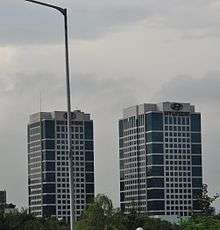 Hyundai Motor Company Headquarters (right) in Seoul, South Korea | |
Native name | 현대자동차 주식회사 |
|---|---|
| Public | |
| Traded as | KRX: 005380 LSE: HYUD OTC Pink: HYMTF |
| ISIN | USY384721251 |
| Industry | Automotive |
| Founded | 29 December 1967 |
| Founder | Chung Ju-yung |
| Headquarters | , South Korea |
Area served | Worldwide (except for North Korea) |
Key people |
|
| Products | Automobiles Luxury cars Commercial vehicles Engines |
Production output | |
| Revenue | |
| Total assets | |
| Total equity | |
Number of employees | 104,731 (2013)[3] |
| Parent | Hyundai Motor Group (2000–present) |
| Divisions | |
| Subsidiaries | List
|
| Website | hyundai |
| Hyundai Motor Company | |
| Hangul | 현대자동차 주식회사 |
|---|---|
| Hanja | 現代自動車 株式會社 |
| Revised Romanization | Hyeondae Jadongcha Jusikoesa |
| McCune–Reischauer | Hyŏndae Chatongch'a Chushik'oesa |
Hyundai operates the world's largest integrated automobile manufacturing facility[6] in Ulsan, South Korea which has an annual production capacity of 1.6 million units. The company employs about 75,000 people worldwide. Hyundai vehicles are sold in 193 countries through some 5,000 dealerships and showrooms.[7]
History
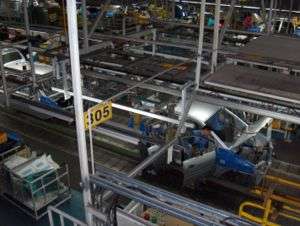
Chung Ju-Yung founded the Hyundai Engineering and Construction Company in 1947. Hyundai Motor Company was later established in 1967, and the company's first model, the Cortina, was released in cooperation with Ford Motor Company in 1968.[8] When Hyundai wanted to develop their own car, they hired George Turnbull in February 1974, the former Managing Director of Austin Morris at British Leyland. He in turn hired five other top British car engineers. They were Kenneth Barnett body design, engineers John Simpson and Edward Chapman, John Crosthwaite ex-BRM as chassis engineer and Peter Slater as chief development engineer.[9][10][11][12] In 1975, the Pony, the first South Korean car, was released, with styling by Giorgio Giugiaro of ItalDesign and powertrain technology provided by Japan's Mitsubishi Motors. Exports began in the following year to Ecuador and soon thereafter to the Benelux countries. Hyundai entered the British market in 1982, selling 2993 cars in their first year there.[13]
In 1984, Hyundai began exporting the Pony to Canada, but not to the United States, as the Pony would not pass emissions standards there. Canadian sales greatly exceeded expectations, and it was at one point the top-selling car on the Canadian market. In 1985, the one millionth Hyundai car was built.[14]
In 1986, Hyundai began to sell cars in the United States, and the Excel was nominated as "Best Product #10" by Fortune magazine, largely because of its affordability. The company began to produce models with its own technology in 1988, beginning with the midsize Sonata. In the spring of 1990, aggregate production of Hyundai automobiles reached the four million mark.[14] In 1991, the company succeeded in developing its first proprietary gasoline engine, the four-cylinder Alpha, and also its own transmission, thus paving the way for technological independence.
In 1996, Hyundai Motor India Limited was established with a production plant in Irungattukottai near Chennai, India.[15]
In 1998, Hyundai began to overhaul its image in an attempt to establish itself as a world-class brand. Chung Ju Yung transferred leadership of Hyundai Motor to his son, Chung Mong Koo, in 1999.[16] Hyundai's parent company, Hyundai Motor Group, invested heavily in the quality, design, manufacturing, and long-term research of its vehicles. It added a 10-year or 100,000-mile (160,000 km) warranty to cars sold in the United States and launched an aggressive marketing campaign.
In 2004, Hyundai was ranked second in "initial quality" in a survey/study by J.D. Power and Associates.[17][18] Hyundai is now one of the top 100 most valuable brands worldwide. Since 2002, Hyundai has also been one of the worldwide official sponsors of the FIFA World Cup.
In 2006, the South Korean government initiated an investigation of Chung Mong Koo's practices as head of Hyundai, suspecting him of corruption. On 28 April 2006, Chung was arrested, and charged for embezzlement of 100 billion South Korean won (US$106 million).[19] As a result, Hyundai vice chairman and CEO, Kim Dong-jin, replaced him as head of the company. On 30 September 2011, Yang Seung Suk announced his retirement as CEO of Hyundai Motor Co. In the interim replacement period, Chung Mong-koo and Kim Eok-jo will divide the duties of the CEO position.[20]
In 2014, Hyundai started an initiative to focus on improving vehicle dynamics in its vehicles and hired Albert Biermann, former Vice President of Engineering at BMW M to direct chassis development for Hyundai vehicles; stating "The company intends to become a technical leader in ride and handling, producing vehicles that lead their respective segments for driver engagement."[21]
Research and development
Hyundai has six research and development centers, located in South Korea (three offices), Germany, Japan and India. Additionally, a center in California develops designs for the United States.[22]
Hyundai has made an app with augmented reality, showing users how to operate and maintain vehicles.[23]
Business
In 1998, after a shake-up in the South Korean auto industry caused by overambitious expansion and the Asian financial crisis, Hyundai acquired the majority of rival Kia Motors. Hyundai owns 33.88% of Kia.[24]
In 2000, the company established a strategic alliance with DaimlerChrysler and severed its partnership with the Hyundai Group. In 2001, the Daimler-Hyundai Truck Corporation was formed. In 2004, however, DaimlerChrysler divested its interest in the company by selling its 10.5% stake for $900 million.
Hyundai has invested in manufacturing plants in North America, India, the Czech Republic, Russia, China and Turkey as well as research and development centers in Europe, Asia, North America and the Pacific Rim. In 2004, Hyundai Motor Company had $57.2 billion in sales in South Korea making it the country's second largest corporation, or chaebol. Worldwide sales in 2005 reached 2,533,695 units, an 11 percent increase over the previous year. In 2011, Hyundai sold 4.05 million cars worldwide and the Hyundai Motor Group was the world's fourth largest automaker behind GM, Volkswagen and Toyota.[25][26] Hyundai vehicles are sold in 193 countries through some 5,000 dealerships.
Board of directors
As of 16 May 2020:[27]
- Chung Eui-sun (chairman), chairman of Hyundai Motors
- Won Hee Lee, president and CEO of Hyundai Motors
- Albert Biermann, president of R&D
- Eon Tae Ha, president of domestic production
- Sang-Hyun Kim, CFO of Hyundai Motors
- Eun Soo Choi, president of the Daejon High Court
- Dong Kyu Lee, secretary-general of the Fair Trade Commission (South Korea)
- Byung Kook Lee, Commissioner of the Seoul Regional Tax Office
- Chi-Won Yoon, CEO of UBS Asia-Pacific
- Eugene Ohr, former partner at Capital Group Companies International
- Sang-Seung Yi, chairman of the Korea Academic Society of Industrial Organization
Design emphasis
In 2006, Hyundai hired Thomas Bürkle as head of the company's design center in Russelsheim, Germany. Bürkle had previously worked for BMW, having designed the BMW 3 Series (E46), and the BMW 6 Series (E63).[28][29] Hyundai's current design philosophy is known as Fluidic Sculpture,[30] which is heavily inspired by nature.[31]
Regional operations
North America

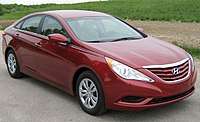
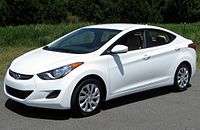
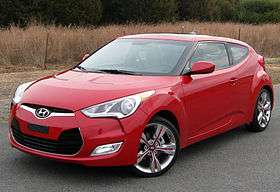

United States
Hyundai Motor America began selling cars in the United States on 20 February 1986, with a single model, the Hyundai Excel, which was offered in a variety of trims and body styles. That year, Hyundai set a record of selling the most automobiles in its first year of business in the United States compared to any other car brand; total sales in 1986 were 168,882.
Initially well received, the Excel's faults soon became apparent; cost-cutting measures caused reliability to suffer. With an increasingly poor reputation for quality, Hyundai sales plummeted, and many dealerships either earned their profits on repairs or abandoned the product. At one point, Hyundai became the butt of many jokes (i.e. Hyundai stands for "Hope you understand nothing's driveable and inexpensive") and even made David Letterman's Top Ten Hilarious Mischief Night Pranks to Play in Space: No.8 – Paste a "Hyundai" logo on the main control panel.[33]
In response, Hyundai began investing heavily in the quality, design, manufacturing, and long-term research of its vehicles. It added free maintenance for the first 2 years or 24,000 miles for all its new cars sold, starting with the 1992 model year. It also added a 10-year or 100,000-mile (160,000 km) powertrain warranty (known as the Hyundai Advantage) to its vehicles sold in the United States. By 2004, sales had dramatically increased, and the reputation of Hyundai cars improved. In 2004, Hyundai tied with Honda for initial brand quality in a survey/study from J.D. Power and Associates, for having 102 problems per 1000 vehicles. This made Hyundai second in the industry, only behind Toyota, for initial vehicle quality. The company continued this tradition by placing third overall in J.D. Power's 2006 Initial Quality Survey, behind only Porsche and Lexus.[34] Hyundai is ranked number 4 in World's Most Admired Companies under the motor vehicles section of CNN, after BMW (Bayerische Motoren Werke), Volkswagen and Daimler in 2011.
Hyundai continues to invest heavily in its American operations as its cars grow in popularity. In 1990, Hyundai established the Hyundai Design Center in Fountain Valley, California. The center moved to a new $30 million facility in Irvine, California, in 2003, and was renamed the Hyundai Kia Motors Design and Technical Center. Besides the design studio, the facility also housed Hyundai America Technical Center, Inc. (HATCI, established in 1986), a subsidiary responsible for all engineering activities in the U.S. for Hyundai. Hyundai America Technical Center moved to its new 200,000-square-foot (19,000 m2), $117 million headquarters in Superior Township, Michigan (near Ann Arbor) in 2005. Later that same year, HATCI announced that it would be expanding its technical operations in Michigan and hiring 600 additional engineers and other technical employees over a period of five years. The center also has employees in California and Alabama.
Hyundai incorporated a new manufacturing facility, Hyundai Motor Manufacturing Alabama, in April 2002. The new plant in Montgomery, Alabama, was completed during 2004, at a cost of $1.7 billion. Production started in May 2005. It employed more than 3,000 workers in 2012.[35] Currently, the plant assembles the Hyundai Elantra, the Hyundai Sonata, and the Hyundai Theta engine. It is Hyundai's second attempt at producing cars in North America since Hyundai Auto Canada Inc.'s plant in Quebec closed in 1993.
Hyundai America Technical Center completed construction of its Hyundai/Kia proving ground in California City, California, in 2004. The 4,300-acre (17 km2) facility is located in the Mojave Desert and features a 6.4-mile (10.3 km) oval track,[6] a Vehicle Dynamics Area, a vehicle-handling course inside the oval track, a paved hill road, and several special surface roads. A 30,000-square-foot (2,800 m2) complex featuring offices and indoor testing areas is located on the premises as well. The facility was built at a cost of $50 million. An aerial view can be found here.[36]
In 2003, Consumer Reports, based on complaints about 2002 model new cars that in general are less than one year usage, ranked Hyundai's reliability tied with Honda's; however, J.D. Power and Associates put Hyundai's 2002 vehicles below the industry average according to its annual Initial Quality Survey, which looks at problems in the first 90 days of ownership.[37]
In 2006, J.D. Power and Associates' quality ranking, overall the Hyundai brand ranked 3rd, just behind Porsche and Lexus, and beating longtime rival Toyota.[38] But Hyundai's ranking fell to twelfth in 2007.[39] However, in 2009, Hyundai was the Highest Ranked Non-Premium Nameplate in the J.D. Power and Associates Initial Quality Study.[40]
In the 2007 Strategic Vision Total Quality Awards, Hyundai Motor leads the most vehicle segments in Strategic Vision's Total Quality Index, measuring the ownership experience. They attempt to measure more than just the number of problems per vehicle. Hyundai tops in Strategic Vision Total Quality Awards. For the first time ever, Hyundai has risen to share the position of having the most models leading a segment. three models with the top Total Quality Index (TQI) score in their segments, including the Hyundai Azera, Entourage, Santa Fe.[41][42]
In 2007 at the New York International Auto Show, Hyundai unveiled its V8 rear-drive luxury sedan called the Concept Genesis to be slotted above the Azera in the Hyundai line-up. This concept made its American debut in mid-2008. The Genesis reintroduced rear-wheel drive to the Hyundai range following a long period of only producing front-wheel drive cars.[43]
In 2007 at the Los Angeles International Auto Show, Hyundai unveiled its second rear-drive concept car, the Concept Genesis Coupe, will be Hyundai's first sports car due to make its debut in early 2009.[44]
In 2008, Hyundai Santa Fe and Hyundai Elantra were awarded 2008 Consumer Reports "top picks". The magazine's annual ratings, based on road tests and predicted safety and reliability are considered highly influential among consumers.[45] The Hyundai Elantra was Consumer Reports' top-ranked 2008 vehicle among 19 other compacts and small family cars, beating out the Honda Civic, Toyota Corolla and Toyota Prius.[46]
In 2008, at the North American International Auto Show, the production version of the luxury and performance-oriented Hyundai Genesis sedan made its debut, dealerships will have the Genesis as soon as summer 2008. In 2008, at the New York International Auto Show, Hyundai debuted its production version of the performance-oriented rear-drive Hyundai Genesis Coupe, slated to hit dealerships in early 2009.
On 6 January, Hyundai reported sales of December 2008 fell to 24,037, from 46,487 in previous year and sales for the year dropped 14%, a day after the company launched 'Hyundai Assurance' in order to spark sales amid tough economic conditions.[47]
In 2009, Hyundai announced the five-door hatchback variant of the Elantra compact sedan will carry the name Elantra Touring when it goes on sale in the spring as a 2009 model.[48]
In 2009, the Hyundai Genesis luxury sedan was named 2009 North American Car of the Year, the first for Hyundai.[49] The Genesis has received a number of well-recognized automobile awards worldwide. It also won the 2009 Canadian Car of the Year after winning its category of Best New Luxury Car under $50,000.[50] The Hyundai's V8 Tau engine in the Genesis, which develops 375 hp (280 kW) on premium fuel and 368 hp (274 kW) on regular fuel, received 2009 Ward's 10 Best Engines award.[51]
In 2009, four models from Hyundai and two from Kia, earned the Top Safety Award by the Insurance Institute for Highway Safety (IIHS).[52]
In 2009, Hyundai/Kia vehicles were named as "least expensive vehicles to insure". Hyundai/Kia vehicles were the least expensive to insure and occupied the 'top five' least expensive slots, said Insure.com.[53]
In 2009, according to a preliminary report from the Environmental Protection Agency published in November 2009, which is based on 2009 pre-model year production projections provided by automakers,[54] Hyundai, at an average of 23.4 mpg‑US (10.1 L/100 km; 28.1 mpg‑imp), is the second most fuel-efficient automaker in America, after Honda's combined U.S. fleet of Honda and Acura models at an average of 23.6 mpg‑US (10.0 L/100 km; 28.3 mpg‑imp).[55]
In 2010, a Consumer Reports reliability survey ranked Hyundai (including Kia) as the fourth-best automaker. The ratings reflect the performance, comfort, utility and reliability of more than 280 vehicles that the magazine recently tested.[56]
In 2010, the Hyundai Equus made its North American debut at the North American International Auto Show
In January 2012, the Hyundai Elantra was named the North American Car of the Year at the North American International Auto Show, selling more than 200,000 cars since the model's redesigned debut.[57]
Canada
The second generation Hyundai Pony was available for sale in Canada starting with the 1984 model year. The Canadian Pony differed from its European counterparts by having 8 km/h bumpers, sealed-beam headlights, side marker lamps, and slightly different instrumentation and interor trim. Sales projections for 1984 called for 5,000 Ponys, but actual sales were closer to 25,000, making the Pony one of Canada's best selling cars that year. A lesser known model, also sold in Canada, was the Hyundai Stellar. Both models were available until 1987, when they were replaced by the Excel.
In 1989, Hyundai Auto Canada Inc. opened a stamping and assembly plant in Bromont, Quebec, employing 800. The plant cost $387.7 million, with Quebec and Canadian federal government subsidies of $131 million.[58] The plant was designed to manufacture approximately 2000 Hyundai Sonatas per week.[58] Subsequently, Chrysler and Hyundai considered a joint venture that would have Chrysler rebranding the Sonata manufactured at Bromont – only to later announce the deal had failed.[59] The Bromont plant was operational for four years before it closed – with Hyundai's sales unable to support the plant. With boost in sales in 2009, Hyundai Auto Canada Inc. is currently planning to build a new plant in Canada and resume production in Canada.[60] Hyundai subsequently sold the plant,[60] which was eventually purchased by Olymbec inc, a Quebec real estate developer. Hyundai is the No.1 import car brand in Canada without a local plant. Sales over 100,000 cars-per-year mark in 2012.
Mexico
Hyundai Motor México entered the Mexican market in 2014 with the Hyundai Grand i10, the Hyundai Elantra, and the Hyundai ix35.[61] Soon afterwards, the Hyundai Sonata joined the lineup. Prior to the introduction of the Hyundai brand for non-commercial vehicles, Hyundai passenger vehicles, light-duty cargo vans, and passenger vans were distributed by Chrysler de México, branded as Dodge.
Panama and Dominican Republic
Hyundai is the number one car brand by sales in Panama and Dominican Republic.
South America
Brazil
Hyundai has been a major presence in the Brazilian luxury car market for some time. In October 2012, Hyundai launched a new small bi-fuel car, the HB20, designed specifically for the Brazilian mass-market. This car, the first product of the new "Projeto HB" (Hyundai Brazil), is built at a new Hyundai factory in Brazil, located in Piracicaba, São Paulo.[62] The HB20 is of very similar size to the Hyundai i20, launched in other parts of the world in 2008.
Hyundai vehicles have also been produced in Brazil at a plant located in Anápolis, Goiás. Production here started with the HR model in 2007, and continued with the Tucson in 2010, the HD78 truck in 2011, and the ix35 in 2013.[63]
Asia
China
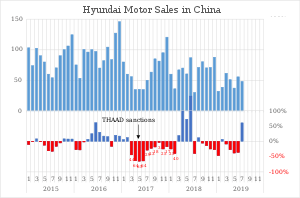
Hyundai cars, including those made by Hyundai's affiliate, Kia Motors, sold well in China until 2016, when sales fell by half, marking the start of a slump that continued into 2019, when the company announced plans to cut jobs in the region.[64]
Hyundai is currently working with its Chinese partner Beijing Automobile Industry Holding Co. to develop an electric car for sale only in China.[65][66] In September 2011, it was announced that Korean celebrity Lee Min Ho, who is popular in China, will promote Hyundai's new 'Veloster' in China.[67]
Hyundai and its sister company, Kia, are losing market share because of their over-reliance on sedans, poor brand images and local Chinese automakers compete with price competitive SUVs.[68]
Beijing Hyundai
A joint venture with Beijing Automotive Group,[69] Beijing Hyundai Motor manufactures many Hyundai vehicles, as well as a few models which are exclusive to the Chinese market.[70] This company sold 700,000 passenger cars in 2010. 855,995 car sales in 2012.[71][72] Beijing Hyundai has 3 assembly plants, each 300,000 unit annual capacity in NE Beijing outskirts. Beijing Hyundai produce most of the taxies in Beijing of the year 2013.
Hawtai partnership
Between 2002[73]-2010,[74] Hawtai Motor made Chinese-market versions of the Hyundai Matrix,[75] the Hyundai Santa Fe[73][76] and the Hyundai Terracan.[73][76] The Santa Fe was the fifth most-purchased SUV in China in 2010,[77] and some of Hawtai's versions may greatly differ from those sold in other markets.[78]
Commercial vehicles
In October 2010, Hyundai signed agreement with Sichuan Nanjun Automobile on setting up a commercial vehicle joint venture—Sichuan Hyundai Motor Co. Ltd.[66]
India
Hyundai Motor India Limited is currently the second largest auto exporter from India.[79][80] It is making India the global manufacturing base for small cars.
Hyundai sells several models in India, the most popular being the Santro Xing, i10,[81] Hyundai EON and the i20. On 3 September 2013, Hyundai launched its much-awaited car, Grand i10[82] in petrol and diesel variants. Other models include the Getz, Accent, Elantra, second generation Verna, Santa Fe and the Sonata Transform. Hyundai has two manufacturing plants in India located at Sriperumbudur in the Indian state of Tamil Nadu. Both plants have a combined annual capacity of 600,000 units. In the year 2007, Hyundai opened its R&D facility in Hyderabad, employing now nearly 450 engineers from different parts of the country. Hyundai Motor India Engineering (HMIE) gives technical & engineering support in vehicle development and CAD & CAE support to Hyundai's main R&D centre in Namyang, Korea. In mid 2014, Hyundai launched Xcent, a sedan based on successful Grand i10. Recently, on 11 August 2014, Hyundai India Motor Limited launched the Elite i20 in petrol and diesel variants.

In 2007, Hyundai started its support engineering centre with CAD/CAE teams in Hyderabad, India. Hyundai expanded its engineering activities in India with Vehicle Engineering team in 2010. In 2011, Hyundai started its design activities at Hyderabad R&D Centre with Styling, Digital Design & Skin CAD Teams and Packaging team. Indian engineers are heavily involved in making of Indian vehicles like Grand i10, Elite i20 along with other Global cars.
In June, 2017, The Competition Commission of India imposed ₹87 crore ($13.6 million) penalty for unfair business practices with respect to providing discounts for cars.[83]
Japan
Despite having growing sales worldwide, Hyundai struggled in Japan, having sold only 15,095 passenger cars from 2001 to 2009.[84][85] Following an announcement on November 2009, Hyundai pulled their passenger car division out of the Japanese market and focused on their commercial vehicle division instead.[84][85] The company said that it is possible for them to come back to Japan fully if market conditions continue to improve.[86] Currently the only Hyundai vehicle available in Japan is the Hyundai Universe bus.
According to the newspaper The Chosun Ilbo, the reason for Hyundai's failure in the car market was due to the company's inability to recognize the value of small cars due to parking spaces. For instance, actor Bae Yong-joon was hired to endorse the mid-sized Sonata in Japan to appeal to the mature housewives who watch Winter Sonata. The marketing campaign backfired, as large sedans are driven primarily by middle-aged men, while housewives prefer compact cars. In addition, the Sonata was priced too similarly to its Japanese rivals, which resulted in poor sales.[87]
But, Hyundai Nexo appeared in G20 Energy Ministerial 2019.
Philippines
Hyundai is currently the third top selling automotive brand in the country. Hyundai's Getz, i10, Accent, SantaFe, Sonata and Grand Starex were among the models which brought Hyundai to the third spot. Hyundai almost doubled its sales in 2010 with 11,086 in 2009 to 20,712.
Indonesia
In November 2019, Hyundai announced that it is building the first Southeast Asian car plant located in Indonesia.[88]
Turkey
In September 1997, Hyundai opened a manufacturing plant in Turkey, located in İzmit, Kocaeli Province. The facility, named Hyundai Assan Otomotiv, was built as a 50-50% joint venture between the Hyundai Motor Company and the Kibar Holding of Turkey, the first stage investment raising to US$180 million.[89] It currently has an annual production capacity of 125,000 units and it manufactured the Accent, the H-100, the Starex, the Matrix and since 2010, the i20.[90] In May 2013 Hyundai Turkey Izmit plant capacity increased up to 200,000 units with 470 million Euro investment. The i10 and i20 are now produced here.[91]
Europe
Germany
Hyundai has been operating an R&D centre in Frankfurt, Germany since 1994,[92] that has been responsible for monitoring technology developments in Europe and designing and engineering new cars for the European market.[93] In September 2003, the company opened its new European headquarters in Rüsselsheim, after an investment worth 50 million euro.[94] The site became the new location for the R&D centre and for the world rally team of the company.[95]
Czech Republic
On November 2008, Hyundai opened its European plant in Nošovice, Czech Republic, following an investment of over 1 billion euros and over two years of construction.[96][97] The plant, which mainly manufactures the i30, ix20, ix35 for the European market, has an annual capacity of 300,000 cars.[98] The new Hyundai plant is 90 kilometres north of Kia Motors' Žilina Plant in Slovakia.
Russia
In Russia, the production of the Hyundai Accent, Sonata, Elantra and Santa Fe models has been taking place at the TagAZ plant,[99] located in Taganrog, since 2001,[100] in the form of complete knock-down kits assembly.[101] Since 2006, the factory has also been assembling the Hyundai Porter,[99] County, Aero Town and the HD 500 commercial vehicles.[100]
In June 2008, Hyundai started the construction of a new manufacturing plant in Saint Petersburg with a planned yearly capacity of 100,000 cars,[102] that will eventually be increased to 200,000 units.[103] It started mass production in January 2011,[103] with two models: the Hyundai Solaris and the Kia Rio.[104]
Africa
Southern Africa
In Botswana, the assembly of Hyundai Accent, Sonata, and Elantra models was undertaken by the Motor Company of Botswana at their Gaborone plant, since February 1993, in the form of complete knock-down kits. Almost all of the finished vehicles were exported across Botswana's border to South Africa, where the vast majority of dealerships are situated.
Egypt
Hyundai cars are also manufactured in Egypt, the local manufacturer is the Ghabbour Group, which is located in Cairo. They have a big model range and offers sports models of some car models which are only offered on the Egypt market. Formerly, the company had assembled vehicles such as the Verna.
Libya
Hyundai is placed at no.1 for car sales in Libya in 2012.
Oceania
Australia
Hyundai sales increases sharply ranking No. 4 position in Australia in 2012. No.2 sales maker without local plant.
New Zealand
A growing market for Hyundai's cars, sales in New Zealand were up 27% in late 2011, compared to 2010 sales.[105]
Electric and hybrid vehicles
Hyundai Motor Company began developing flexible-fuel vehicles (FFVs) in 1988. The test vehicle was 1991 MY Scoupe FFV.[106] Since March, 1992, in Seoul, Korea, through at least November 1993, field trials of several FFVs had been performed over more than 30,000 miles.[106]

The first pure electric car developed by Hyundai was the Sonata Electric Vehicle in 1991. The car started as a Sonata sedan based model.[107] Hyundai later produced electric vehicles utilizing the Excel, Grace, Accent, Atos and Kia Sportage platforms.
Hyundai planned to have six electric vehicles available for testing by the end of 1992. The company was using batteries from Ovonic Battery Company Inc. in Troy, Michigan.[108] The Excel and the Sonata were the two different models on which the electric vehicles were based. The vehicles were scheduled to likely be tested in the United States and in Korea.
The new hybrid-electric FGV-1 was unveiled at the Seoul Motor Show in 1995. The car featured full-time electric drive technology.[109] The 1995 Hyundai FGV-1 was the result of Hyundai's first experiments with hybrid propulsion systems in 1994.
Hyundai produced its second generation hybrid-electric vehicle in 1999. The company is using the “parallel” type design, which utilizes either the ICE or the electric motor.[109] The FGV-2 was the second vehicle to be produced. Others are the Elantra HEV and the Hyundai Accent HEV, which were unveiled in 1999 and 2000, respectively.[109]
The new hybrid electric Sonata made its debut at the Los Angeles International Auto Show in November 2008. The car featured lithium polymer battery technology.[110] The 2011 Hyundai Sonata Hybrid sales in the U.S. began near the end of February 2011.
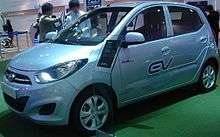
Hyundai began producing hybrid electric vehicles in 2009. The company is using Hybrid Blue Drive, which includes lithium polymer batteries, as opposed to lithium-ion.[111][112][113] The Avante was the first vehicle to be produced. Other are the Santa Fe Hybrid, the Elantra, Sonata Hybrid[114] and the Hyundai i20, which will replace the Hyundai Getz.
Hyundai Elantra LPI Hybrid[115] (or Avante in the local market) was launched in the South Korean domestic market in July 2009. The Elantra LPI (Liquefied Petroleum Injected) is the world's first hybrid electric vehicle to be powered by an internal combustion engine built to run on liquefied petroleum gas (LPG) as a fuel. The Elantra PLI is a mild hybrid and the first hybrid to adopt advanced lithium polymer (Li–Poly) batteries.[116][117]
The Hyundai Blue Will plug-in hybrid has made its U.S. debut at the North American International Auto Show in Detroit 2010.[118][119]
At the 2010 Geneva Motor Show, Hyundai unveiled the i-flow, a concept car using a variant of the BLUE-WILL hybrid system. The i-flow Concept uses a 1.7-liter twin-turbo diesel engine along with electric batteries to achieve fuel economy of 3 litres per 100 kilometres (94 mpg‑imp; 78 mpg‑US). Hyundai says a production car based on the i-flow's design will be in production by 2011.[120]
The Hyundai BlueOn is a subcompact five-door hatchback electric car produced by Hyundai Motor Company. The prototype, an electric version of i10, was first unveiled at the Frankfurt Motor Show in 2009. The pre-production testing model was unveiled in Seoul in September 2010, when the first of 30 units were delivered to South Korean government agencies for field testing. The carmaker planned to build 2,500 units by the end of 2012. The BlueOn is equipped with a LG 16.4 kWh lithium polymer (Li–Poly) battery pack and charges in 6 hours with a 220 V power outlet and in 25 minutes to 80% with three-phase electric power (in a 380 V outlet). The maximum speed is 130 km/h (81 mph) and 0–100 km/h is achieved in 13.1 seconds. According to Hyundai Motor Company, the total investment to develop the BlueOn, its first production electric car, was around 40 billion won (US$34.3 million).[121][122]
As of March 2014, cumulative global sales totaled 200 thousand hybrids, including both Hyundai Motors and Kia Motors hybrid models.[123]
Environmental record
On 23 April 2008, Hyundai Motor announced the beginning of a five-year project to turn 50 km² of infertile land into grassland by 2012. Hyundai is doing so with the help of the Korean Federation for Environmental Movement (KFEM). The project, named Hyundai Green Zone, is located 660 km north of Beijing. The goal of the project is to end the recurring dust storms in Beijing, block desertification and protect the local ecosystem. Local weeds will be planted in the region that have the ability to endure sterile alkaline soil. This is the first environmental project of the company's social contribution programme. Hyundai also made electric car concept i10 recently.[124][125]
Hyundai Motor plans to aid Chevron Corporation in the construction of up to six hydrogen fueling stations that will be located in California, including locations at the University of California-Davis and the Hyundai America Technical Center in Chino. Hyundai is going to provide a collection of 32 Tucson fuel cell vehicles, which are powered by UTC Fuel Cell power plants.[126]
Motorsport
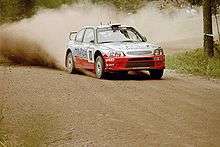
Hyundai entered motorsport by competing in the F2 class of the World Rally Championship in 1998 and 1999. In September 1999, Hyundai unveiled the Accent WRC, a World Rally Car based on the Hyundai Accent. The Hyundai World Rally Team debuted the car at the 2000 Swedish Rally and achieved their first top-ten result at that year's Rally Argentina, when Alister McRae and Kenneth Eriksson finished seventh and eighth, respectively. Eriksson later drove the car to fifth place in New Zealand and fourth in Australia. In 2001, Hyundai debuted a new evolution of the Accent WRC, which was intended to improve reliability, but the performance of the car was still not good enough to challenge the four big teams (Ford, Mitsubishi, Peugeot and Subaru). However, at the season-ending Rally GB, the team achieved their best result with McRae finishing fourth and Eriksson sixth.
For the 2002 season, Hyundai hired the four-time world champion Juha Kankkunen, along with Freddy Loix and Armin Schwarz. Kankkunen's fifth place in New Zealand was the team's best result, but they managed to edge out Škoda and Mitsubishi by one point in the battle for fourth place in the manufacturers' world championship. In September 2003, after a season hampered by budget constraints, Hyundai announced withdrawal from the WRC and planned to return in 2006, which did not happen.[127]
In 2006, following the announcement that Korea was scheduled to earn a Formula One Grand Prix, Hyundai planned to enter the sport.[128] The Korean Grand Prix was first held in 2010, but Hyundai have not entered the championship. Hyundai announced they would be revealing their future rally plans at the 2011 Chicago Auto Show, on February 9.[129] The current plans for rallying are focused around the newest Hyundai release, the Veloster.[130] In September 2012 Hyundai announced that they were due to start the WRC with a rally model of its i20 to rival the likes of the Ford Fiesta, the Citroen DS3 and the Mini Countryman.
Hyundai i20 WRC
The Hyundai i20 WRC is a World Rally Car built by Hyundai for use in the 2014 World Rally Championship.[131] It is based on the Hyundai i20 subcompact car, and was unveiled at the 2012 Paris Motor Show. The launch of the i20 marks Hyundai's return to the World Rally Championship after a ten-year absence.[132] The car is scheduled to make its first competitive appearance at the 2014 Rallye Monte Carlo, but may compete during the 2013 season to aid development.[133]
The car will be operated by Hyundai's performance division, Hyundai Motorsport from a base in Frankfurt, Germany.[134]
Model lineup
Current
Sedans, hatchbacks and sports cars
- Accent/Verna
- Elantra/Avante/Lantra
- Ioniq
- Grandeur/Azera/XG (1st and 2 ng gen are originally a joint project of Hyundai and Mitsubishi)
- i10/Grand i10
- i20
- i30
- i40
- Mistra (Joint project of BAG and Hyundai)
- Reina
- Santro
- Sonata
- Veloster
- Xcent
Former
- Aslan
- Atos/Atoz/Santro
- Coupé/Tiburon/Tuscani
- Dynasty
- Eon
- Excel
- Equus/Centennial (Originally a joint project of Hyundai and Mitsubishi)[135]
- Scoupe
- Genesis
- Genesis Coupe
- Getz/Click/Getz Prime/TB
- i30/i30cw//i30 Tourer/Elantra Touring
- ix20
- Lavita/Matrix
- Marcia
- Pony
- Santamo (Rebadged Mitsubishi Chariot; originally produced by Hyundai Precision Industry)
- Stellar
SUVs and vans
Current
- Creta
- H-1/iMax/iLoad/H300/i800/Satellite/Starex/Grand Starex
- Porter 2
- Santa Fe
- Santa Fe Sport/Santa Fe LWB
- Tucson
- Kona
- Nexo
- Palisade
- Venue
Former
- Entourage (Similar to the Kia Sedona)
- Galloper (Rebadged Mitsubishi Pajero; originally produced by Hyundai Precision Industry)
- Grace (1st generation was a rebadged Mitsubishi Delica)
- HD1000 (Minibus/Porter)
- H-1/Satellite/H200/Libero
- ix35
- Trajet
- Terracan
- Veracruz/ix55
Commercial vehicles
- HM 1620 urban bus
- HM 1630 suburban bus
- Hyundai 4.5 to 5-ton truck (Rebadged Mitsubishi Fuso Fighter)
- Hyundai 8 to 25-ton truck (Rebadged Mitsubishi Fuso Super Great)
- Aero (Rebadged Mitsubishi Fuso Aero Bus)
- Aero City
- Aero Town (e-Aero Town)
- Bison & 3ton Truck
- Chorus
- County (e-County)
- Hyundai DQ-7
- Hyundai ElecCity
- e-Mighty
- Hyundai FB
- H350/Solati
- HD160
- HD170
- Mega Truck
- New Power Truck
- Nova (made by Ghabbour Group in Egypt[136])
- Mighty (Rebadged Mitsubishi Fuso Canter)
- Mighty II
- Hyundai RB
- Super Truck Medium
- Super Truck
- Trago
- Universe
- O303 Benz Bus
- Xcient
- Pavise – Launched in South Korean market in September 2019.
Concept Vehicles
Marketing
Live Brilliant
The Live Brilliant global brand campaign started in 2012. That campaign will be an extension of the “Modern Premium” way of thinking that Hyundai adopted as part of their new brand direction. The goal was to seek to deliver the company's aspiration to make each and every moment a customer spends with Hyundai a moment of happiness, filled with brilliant memories. [139][140][141][142]
Corporate social responsibility
In 2008, Hyundai Motors established a committee to oversee its Corporate Social Responsibility programme.[143] Among the programme's initiatives have been the "Happy Move Global Youth Volunteers Program".[144]
The Hyundai Motors' India Foundation (HMIF) has invested more than 20 million rupees in various corporate social responsibility programmes in India. In 2011, it started the "Go Green" village adoption project in Tamil Nadu. Its aim was to promote environmentally friendly products, increase the forest cover in Tamil Nadu, and improve living and hygiene conditions in the region's villages. A number of schools have been adopted for improvement with the HMIF donating around 450 benches to government schools and drilling 10 bore wells.[145]
Sports sponsorship
- BCCI
- Jeonbuk Hyundai Motors FC
- FIFA
- International Cricket Council
- UEFA
- FIFA World Cup (since 2002)[146]
- Cricket World Cup
- UEFA European Championship (since 2000)[147]
- Korea Football Association
- A-League
- Inside the NBA
- National Football League[148]
- Sun Bowl[149]
- Hyundai Tournament of Champions
- Olympique Lyonnais
- PFC CSKA Moscow
- Millonarios Fútbol Club
- Club Universitario de Deportes
- Tampines Rovers FC
- Al-Fateh SC
- Moroka Swallows F.C.[150]
- Mandurah City FC[151]
- Park United FC[152]
- Carlton Football Club[153]
- Brisbane Lions
- Brisbane Broncos
- AS Cannes Volley-Ball
- Hyundai Hockey Helpers[154]
- Rhys Millen[155][156]
- Atlético Madrid[157]
- Hertha BSC
- Chelsea FC
- AS Roma
Other sponsorships
- Academy Awards
- CNN Worldwide
- Hyundai Auto Club Philippines
Controversies
Inflated fuel economy numbers
After an investigation in 2012, the EPA found that 35% of all 2011-2013 Hyundai and Kia vehicles had inflated fuel economy numbers; by as much as six miles per gallon. Currently, Hyundai and Kia have started a reimbursement programme for the owners of the 2011–2013 affected vehicles. [158][159][160] In 2014 the company was issued $350 million in penalties by the US government, agreed to pay $395 million in 2013 to resolve claims from vehicles owners, and agreed to pay $41.2 million to cover the "investigative costs" of 33 US state attorneys general.[161]
Wrongly advertised engine and horsepower
Several consumers complained that the engine delivered with the Hyundai Veloster in Brazil was inferior to the one advertised.[162] Independent tests confirmed that it was not the same engine, and it delivered only 121 CV (119 HP) instead of the advertised 140 CV (138 HP), with the car earning derogatory nicknames like Slowster in the Brazilian market.[163]
Marketing controversy
In April 2013, Hyundai Motors UK released a commercial depicting a man attempting to commit suicide via carbon monoxide poisoning in an ix35, only to fail to do so because of the vehicle's non-toxic emissions. The advert, produced by Hyundai's in-house agency Innocean Worldwide, received widespread criticism for promoting suicide.[164] Blogger Holly Brockwell posted an open letter to Innocean and Hyundai, reminding them that her father committed suicide in a similar manner.[165] Hyundai has since taken down the video and issued a formal apology.[164][166]
See also
- Bering Truck Corporation
- Hyundai Group
- Hyundai Mobis
- Hyundai Motor Group
- Hyundai Motor Manufacturing Alabama
- Kia Motors
- List of Hyundai engines
- List of Korean car makers
- List of Hyundai Motor Company transmissions
References
- "Hyundai Motor 2016 Fast Facts".
- "Hyundai Motor Company and Its Subsidiaries Consolidated Financial Statements as of and for the Years Ended December 31, 2019 And 2018" (PDF). pp. 6–8. Retrieved 19 March 2020.
- "Hyundai Motor 2015 Fast Facts" (PDF). hyundaiproductinformation.com/.
- Pronunciations in English vary. Among the variants are:
- /ˈh(j)ʌndeɪ/ H(Y)UN-day
- /ˈh(j)ʌndaɪ/ H(Y)UN-dy
- /haɪˈuːndaɪ/ hy-OON-dy
- /hiˈʌndeɪ/ hee-UN-day
- Kim, Sohee (4 November 2015). "Hyundai launches Genesis premium car brand in bid to end profit skid". Reuters. Retrieved 5 November 2015.
- Taylor III, Alex (5 January 2010). "Hyundai smokes the competition". CNN.
- "Hyundai ships 10 millionth car overseas". the korea herold. Retrieved 31 March 2016.
- Steers, Richard M. (21 August 2013). Made in Korea: Chung Ju Yung and the Rise of Hyundai. Routledge. ISBN 9781136600388 – via Google Books.
- The Times (1974-07-09)
- The Sunday Times 'Business News' (1974-07-14)
- Motor Report International (1974-07-18)
- The Engineer (1975-01-30)
- Fisher, Brian (10 March 1983). "Lotus, R-R & Co". Le Moniteur de l'Automobile (in French). 34 (764): 28.
- Sundfeldt, Björn, ed. (2 May 1991). Teknikens Värld (in Swedish) (9): 8. Missing or empty
|title=(help) - "Hyundai Motor India Ltd". Business.mapsofindia.com. 9 April 2010. Retrieved 17 December 2010.
- "Chung Mong-koo". Business Week. Archived from the original on June 5, 2012.
- "Explore Used Hyundai Models with Allen Turner Pre-Owned". Allen Turner Pre-Owned. Archived from the original on January 8, 2018. Retrieved January 8, 2018.
- "수상내역 : 2004 – 기업정보 – 회사소개 | 현대자동차". Hyundai Motors (in Korean). Retrieved 22 April 2018.
- Sang-hun, Choe (28 April 2006). "South Korea Arrests Head of Hyundai Motor". New York Times.
- Evan Ramstad (3 October 2011). "Hyundai CEO's Departure Is Year's Second Sudden Exit". The Wall Street Journal.
- "Albert Biermann appointed Head of Vehicle Test & High Performance".
- "Hyundai research & development | Hyundai Motor Company". Worldwide.hyundai.com. 10 June 2010. Archived from the original on 19 April 2013. Retrieved 24 April 2011.
- "Hyundai's augmented reality manual: A simple but extremely good idea". 2016.
- "Kia Motors Shareholders". Kia Motors. Retrieved July 24, 2016.
- "Hyundai Hunts Big Three in Auto Race". AutoGuide. Retrieved 1 December 2012.
- "Hyundai Beats Ford, Becomes World's 4th Automaker". autoevolution. 12 August 2009. Retrieved 20 September 2010.
- https://www.hyundai.com/worldwide/en/company/ir/corporate-information/bod/board-of-directors Hyundai Board
- "Thomas Burkle's Career Gamble". GoAuto. 19 October 2011. Retrieved 12 August 2013.
- "Thomas Bürkle". Hyundai Motor UK Ltd. Archived from the original on 2 October 2013. Retrieved 12 August 2013.
- "For Design". Archived from the original on 17 June 2015. Retrieved 17 June 2015.
- "'Fluidic Sculpture' – Hyundai's Design Philosophy is Inspired by NATURE!". ReviewHyundai.com. March 22, 2013. Archived from the original on August 8, 2013. Retrieved August 12, 2013.
- "2011 Hyundai Sonata Named IIHS Top Safety Pick". U.S. News Rankings & Reviews. 19 February 2010.
- TBD. "Letterman Top Ten jokes about Hyundai". CBS. Archived from the original on 10 December 2008. Retrieved 17 December 2010.
- "Porsche, Hyundai score big gains in J.D. Power quality survey". AutoWeek Magazine. 6 August 2006. Archived from the original on 28 June 2011. Retrieved 17 December 2010.
- "About HMMA". Hyundai Motor Manufacturing Alabama. Hyundai Motor Company. Retrieved 20 September 2012.
- "Google Maps". Google Maps. Retrieved 17 January 2019.
- Eldridge, Earle (11 March 2003). "Hyundai's reliability rankings now tie Honda's". USA Today. Retrieved 17 December 2010.
- "J.D. Power Announces Hyundai Ranks Top in Customer Satisfaction". Motortrend.com. 13 December 2010. Retrieved 17 December 2010.
- "Ford beats Toyota in quality rankings". NBC News. AP. 6 June 2007.
- Hyundai is the Highest Ranked Non-Premium Nameplate in the J.D. Power and Associates Initial Quality Study 2009. The autochannel
- "The 2007 Total Quality Award Winners". Strategic Vision. Archived from the original on July 16, 2011. Retrieved December 17, 2010.
- "Hyundai models tally tops Strategic Vision’s 2007 quality perception awards" Archived March 15, 2014, at the Wayback Machine
- Hyundai Concept Genesis – 2007 New York Auto Show Archived September 28, 2009, at the Wayback Machine
- "Hyundai Unveils Rear-Wheel-Drive Genesis Coupe Concept". Worldcarfans.com. Retrieved 17 December 2010.
- "Hyundai breaks through with two 'top' models". NBC News. 28 February 2008. Retrieved 17 December 2010.
- "Gas-saving sedans, The refined Elantra SE beats the very thrifty Corolla". Consumerreports.org. 11 February 2010. Retrieved 17 December 2010.
- Alan Ohnsman and Mike Ramsey (6 January 2009). "Toyota, Honda U.S. Slump Ends Gains Dating to Mid-90s". bloomberg.
- "Hyundai announces Elantra hatchback". Blogs.motortrend.com. 8 August 2007. Retrieved 17 December 2010.
- "2009 North American Car of the Year". NACOTY. January 11, 2009. Archived from the original on February 3, 2014.
- "2009 Canadian Car of the Year" (PDF). Automobile Journalists Association of Canada. 24 October 2008. Archived from the original (PDF) on 10 April 2009. Retrieved 13 May 2009.
- "Ward's 2009 10 Best Engines Winners". WARD'S. December 5, 2008. Archived from the original on September 26, 2011. Retrieved August 9, 2010.
- Top Safety Picks 2009, Insurance Institute for Highway Safety, 2009
Hyundai Genesis, Hyundai Entourage, Kia Sedona, Hyundai Santa Fe, Hyundai Veracruz, Kia Soul - The Most Expensive Cars to Insure Archived January 10, 2016, at the Wayback Machine (2009-06-03), U.S. News Rankings & Reviews
- "Light-Duty Automotive Technology, Carbon Dioxide Emissions, and Fuel Economy Trends: 1975 Through 2009". U.S. Environmental Protection Agency. 4 May 2016.
- Makiko Kitamura and Alan Ohnsman (23 June 2010). "Honda's Ito Defends Fuel Efficiency Lead as Hyundai Gains". Bloomberg.
- "Best Car Manufacturers – Best Cars 2012 – Consumer Reports". Retrieved 17 June 2015.
- "Most Popular E-mail Newsletter". USA Today. 9 January 2012.
- "Hyundai to Add Quebec Plant". The New York Times. AP. 5 July 1989. Retrieved 4 May 2010.
- Doron P. Levin (24 July 1990). "Chrysler and Hyundai Venture Off". The New York Times. Retrieved 4 May 2010.
- Tony Van Alphen (September 14, 2009). "Hyundai CEO wants Canadian car plant". The Toronto Star. Archived from the original on October 8, 2009. Retrieved May 4, 2010.
- Rubén Hoyo. "Hyundai llega a México, te decimos todo lo que hay que saber". Retrieved 17 June 2015.
- "Brazil factory, the new standard-bearer of the Brazilian market". Hyundai Motor Company. Retrieved 31 January 2014.
Brazil factory, which began mass production in September 2012 and selling cars from October [...]
- "Sobre a Hyundai CAOA do Brasil" (in Portuguese). Hyundai CAOA do Brasil. Retrieved 31 March 2016.
- "Hyundai Motor to cut China jobs after sales slump". Reuters. 25 January 2019. Retrieved 5 March 2019.
- Terlep, Sharon (16 September 2011). "Road Gets Bumpy for GM in China". Wall Street Journal.
- "Hyundai Picks Sichuan Nanjun for Commercial Vehicle Joint Venture". ChinaAutoWeb.com.
- "Lee Min-ho chosen to model for Hyundai 'Veloster' in China". HanCinema. 20 September 2011.
- "South Korea carmakers see China sales plummet further amid political tension – sources". Reuters. 4 May 2017. Retrieved 6 May 2017.
- "Beijing Hyundai Opens New Plant, Adds New Model" (Press release). Hyundai. Archived from the original on July 12, 2011. Retrieved January 28, 2011.
- "Hyundai Reveals Three New Models at Shanghai Auto Show" (Press release). Hyundai. Archived from the original on July 12, 2011. Retrieved January 28, 2011.
- Hyundai sells 1M cars in China joongangdaily.com, (2011-01-03) Archived July 13, 2011, at the Wayback Machine
- "OSEN – 현대·기아차, 中 누적 생산·판매 700만 대 돌파". Retrieved 17 June 2015.
- A New Bentley? No, It Is a Hawtai B11 chinaautoweb.com, (2010-08-17)
- Hawtai to launch B35 SUV at years end Archived October 26, 2013, at the Wayback Machine China Car Times (2010-11-15)
- Huatai Automobile to manufacture Hyundai matrix gasgoo.com, 06, 2008
- World of Cars 2006·2007. Warsaw, Poland: Media Connection Sp. z o.o. 2006. p. 226.
- Top 10 Best-Selling Sedans and SUVs in 2010 chinaautoweb.com, 2011-01-14
- "Huatai-Hyundai and Roewe hook up to stick 1.8T in SanteFe". China Car Times. 11 October 2007. Archived from the original on 1 April 2012.
- Correspondent, Special. "Hyundai plans to enter three new segments". The Hindu. Retrieved 9 March 2017.
- Nikhil Gulati, Santanu Choudhury (11 August 2009). "Vehicle Sales in India Surge 31%, the Fastest Pace in Over Two Years". Wall Street Journal. Retrieved 11 August 2009.CS1 maint: uses authors parameter (link)
- PTI. "Hyundai decides to pull the plug on i10". The Hindu. Retrieved 9 March 2017.
- "2017 Hyundai Grand i10 facelift ready for launch". The Hindu. Retrieved 9 March 2017.
- "Competition Commission slaps Rs 87 crore fine on Hyundai Motor India". The Times of India. 14 June 2017.
- Brogan, Matt (30 November 2009). "Hyundai suspends Japanese sales". CarAdvice. Retrieved 4 July 2011.
- Gauthier, Michael (1 December 2009). "Hyundai Pulls Out of Japanese Market". Motorsport Network. Retrieved 3 September 2019.
- "Hyundai suspends passenger vehicle sales in Japan". The Times of India. 28 November 2009. Retrieved 4 July 2011.
- "Why Hyundai Failed to Conquer Japan". The Chosun Ilbo. 27 November 2006. Retrieved 3 September 2019.
- "Hyundai Motor to invest $1.55 billion in first Indonesia car plant". Reuters. 26 November 2019. Retrieved 26 November 2019.
- "Hyundai Assan". Hyundai Assan Otomotiv. Retrieved 7 April 2013.
- "Hyundai Türkiye fabrikasi 500 bininci aracini üretti". Hyundai Assan Otomotiv. 21 August 2009. Retrieved 7 April 2013.
- "증설공사 마무리단계 현대차 터키공장 가보니." 18 April 2013. Retrieved 17 June 2015.
- Daechang Lee (July 1997). "Korean Automotive Industry in Transition" (PDF). Kia Economic Research Institute. p. 23. Retrieved 6 April 2013.
- Kim, Linsu (1998). "Crisis Construction and Organizational Learning: Capability Building in Catching-up at Hyundai Motor". Organization Science. 9 (4): 506–521. CiteSeerX 10.1.1.137.2033. doi:10.1287/orsc.9.4.506.
- "New European Hyundai Motor Headquarters in Rüsselsheim". Presseportal. September 8, 2003. Archived from the original on May 21, 2013. Retrieved April 7, 2013.
- "Annual Report 2003" (PDF). Hyundai Motor Company. 26 June 2004. p. 29. Retrieved 7 April 2013.
As part of the reorganization, the company will establish a new World Rally Team Headquarters at the Design and Technical Centre in Russelsheim, Germany
- Agence France-Presse (January 25, 2006). "Hyundai Considers Czech Auto Plant". IndustryWeek. Archived from the original on July 13, 2011. Retrieved December 12, 2009.
- "Mass Production Officially Launched at the New Hyundai Plant in the Czech Republic". Automobiles Review. 15 November 2008. Retrieved 12 December 2009.
- Kalab, Vladimir (4 November 2008). "First Czech-made Hyundai Cars Leaving Nošovice Plant". Prague Daily Monitor. Retrieved 12 December 2009.
- "Модельный ряд" [Model line-up]. TagAZ. Retrieved 14 April 2013.
- "Hyundai Truck & Bus Newsletter" (PDF). Hyundai Motor Company. 17 March 2006. p. 11. Retrieved 14 April 2013.
RZGA is an affiliate of TAGAZ, a Russian automobile company that has assembled CKD kits of HMC’s passenger cars since 2001.
- "Global Production Systems" (PDF). Hyundai Motor Company. 29 June 2012. p. 39. Retrieved 14 April 2013.
- "Под Петербургом началось строительство завода Hyundai" [Near St. Petersburg the construction of the Hyundai plant began] (in Russian). Motor.ru. 5 June 2008. Retrieved 14 April 2013.
- "Manufacturing – Russia Plants". Hyundai Motor Company. Retrieved 14 April 2013.
- "2013 Quick Facts". Hyundai Motor Company. Retrieved 14 April 2013.
- "Hyundai Fastest Growing Car Brand Two Years Running". Digital Journal. Retrieved 10 October 2011.
- "Performance and Exhaust Emissions of Hyundai Flexible Fuel Vehicle (FFV)". Society of Automotive Engineers, Inc. 1 November 1993. Retrieved 6 January 2015.
- "Hyundai Among Leaders in Development of Environmentally Friendly Vehicles for the 21st Century". Hyundai News. November 1, 2000. Archived from the original on July 3, 2013. Retrieved December 29, 2012.
- "Nuts & Bolts – Toyota tackling door lock problem". The Atlanta Journal and The Atlanta Constitution. 11 September 1992. Retrieved 29 December 2012.
- "Hyundai's Clean Green Machine: The TB HEV (Hybrid Electric Vehicle)". Hyundai News. October 31, 2003. Archived from the original on July 3, 2013. Retrieved December 28, 2012.
- "report". Reuters. 20 August 2008. Retrieved 17 December 2010.
- "LA 2008: Hyundai announces Blue Drive efficiency strategy, 2010 Sonata hybrid". Autoblog.com.
- "Green Car Congress site". Greencarcongress.com. 3 September 2008. Retrieved 17 December 2010.
- "Hyundai reveals hybrid blue drive architecture in Los Angeles". Worldcarfans.com. Retrieved 8 November 2011.
- "Hyundai Sonata hybrid". Auto-Power-Girl.com. Retrieved 18 December 2014.
- "Hyundai Elantra LPI Hybrid". Auto-Power-Girl.com. Retrieved 18 December 2014.
- "Hyundai Elantra LPi hybrid official press release". Hyundai. July 10, 2009. Archived from the original on July 17, 2009. Retrieved March 23, 2010.
- "Hyundai Unveils Elantra LPI HEV at Seoul Motor Show". Hyundai Global News. 2 April 2009. Retrieved 23 March 2010.
- "Hyundai Blue-Will, a plug-in hybrid". Engadget.com. 25 March 2009. Retrieved 17 December 2010.
- "Hyundai's futuristic plug-in hybrid Blue-Will has Detroit auto show debut". USA Today. 11 January 2010. Retrieved 4 May 2010.
- "Hyundai i-flow Concept Revealed at Geneva". Automoblog.net. 4 March 2010. Retrieved 17 December 2010.
- Hyundai Press Release (9 September 2010). "Hyundai Unveils its First Electric Car 'BlueOn'". Autoblog. Retrieved 10 September 2010.
- "Hyundai rolls out first electric car: BlueOn". The Detroit News. 10 September 2010. Retrieved 10 September 2010.
- IHS Inc. (16 May 2014). "News – Hyundai-Kia reports cumulative global hybrid sales of 200,000 units". IHS Technology. Archived from the original on 6 October 2014. Retrieved 5 October 2014.
- "Hyundai to Green Mongolian Desert" Archived April 3, 2016, at the Wayback Machine. Korean Times. (2008-04-24). Retrieved 2008-05-18.
- "Hyundai Motor to Begin 'Green Project' in China" Archived April 3, 2016, at the Wayback Machine Korean Times. (2008-04-23). Retrieved 2008-05-16
- "U.S. Hydrogen Highway Paved with Public-Private Research Funds". Environment News Service, (2004-04-28). Retrieved 2008-05-16
- "Hyundai to quit World Rally". BBC. 17 September 2003. Retrieved 3 November 2008.
- Lavrinc, Damon (23 October 2006). "Hyundai to Enter F1 in 2010". Autoblog. Retrieved 17 December 2010.
- "Hyundai's Getting Dirty". Blog.roadandtrack.com. February 4, 2011. Archived from the original on February 9, 2011. Retrieved April 24, 2011.
- "Hyundai Future Cars". Hyundaiusa.com. Archived from the original on 23 April 2011. Retrieved 24 April 2011.
- Evans, David (17 December 2012). "Hyundai World Rally Car makes European test debut". Autosport.com. Haymarket Publications. Retrieved 17 December 2012.
- "Hyundai". World Rally Archive. Retrieved 27 September 2012.
- Evans, David (27 September 2012). "Hyundai reveals new i20 World Rally Car". Autosport.com. Haymarket Publications. Retrieved 27 September 2012.
- Evans, David (19 December 2012). "Hyundai's early WRC effort was more than just a show car". Motorsport News.
- "Automotive Engineering International Online: Global Vehicle Development: Part III Asia". Sae.org. Archived from the original on June 5, 2011. Retrieved December 17, 2010.
- Icon Creations. "Ghabbour Auto". www.ghabbourauto.com. Retrieved 17 June 2015.
- "Geneva: Hyundai i-oniq Concept Evolves Hyundai Design". Automoblog.net. 6 March 2012. Retrieved 6 March 2012.
- "Hyundai Unveils 'Walking Car' That Could Be the Future of Search-and-Rescue Missions". Geek.com. 8 January 2019. Retrieved 8 January 2019.
- "live brilliant". Archived from the original on 17 June 2015. Retrieved 17 June 2015.
- "Global News – Hyundai Worldwide". Retrieved 17 June 2015.
- Hyundai-Blog. "Live Brilliant". Archived from the original on June 17, 2015. Retrieved June 17, 2015.
- "Articles – Best Global Brands – Interbrand". Archived from the original on September 17, 2014. Retrieved June 17, 2015.
- Kim Yoo-chul (4 June 2008). "Hyundai-Kia Will Upgrade Corporate Transparency" Archived April 3, 2016, at the Wayback Machine. Korea Times
- ABS-CBN News and Current Affairs (13 January 2011). "Hyundai brings youth volunteers to PH".
- One India (21 July 2011). "Hyundai Foundation's New Initiatives In TN"
- "FIFA Worldcup – Sponsorship Activity – Hyundai Worldwide". Retrieved 17 June 2015.
- "Hyundai UEFA EURO – Sponsorship Activity – Hyundai Worldwide". Retrieved 17 June 2015.
- "Hyundai announces official NFL automotive sponsorship".
- "Sponsors". Retrieved 17 June 2015.
- "Archived copy". Archived from the original on October 28, 2014. Retrieved October 28, 2014.CS1 maint: archived copy as title (link)
- "Archived copy". Archived from the original on 7 November 2014. Retrieved 28 October 2014.CS1 maint: archived copy as title (link)
- "Park United". Archived from the original on 28 October 2014. Retrieved 17 June 2015.
- "Sponsorships". Retrieved 17 June 2015.
- "Hyundai Hockey Helpers". Archived from the original on 28 October 2014. Retrieved 17 June 2015.
- "Hyundai Genesis Coupe and Rhys Millen Racing Partner to Compete In 2012 Formula Drift Series". Retrieved 17 June 2015.
- "Our Sponsors". Rhys Millen Racing. Retrieved 17 June 2015.
- https://www.soccerex.com/insight/articles/2018/atl%C3%A9tico-madrid-park-up-with-hyundai
- Gorzelany, Jim (2 November 2012). "EPA Slams Hyundai and Kia for Overestimating MPG". Forbes. Retrieved 11 December 2012.
- Hirsch, Jerry (2 November 2012). "Hyundai, Kia inflated fuel economy claims on 900,000 cars, EPA says". LA Times. Retrieved 11 December 2012.
- Healey, James (4 November 2012). "Hyundai/Kia false mpg may bring industry-wide EPA probe". USA Today. Retrieved 11 December 2012.
- Shepardson, David (27 October 2016). "Hyundai, Kia to pay $41.2 million to U.S. states over mileage claims". Reuters. Retrieved 12 March 2018.
- "A polêmica do Veloster: 140 ou 128 cv?". Revista Quatro Rodas. October 28, 2011. Archived from the original on August 22, 2014. Retrieved August 21, 2014.
- "Veloster entra no dinamômetro e tem rendimento abaixo do anunciado". UOL Carros. January 31, 2012. Archived from the original on September 4, 2014. Retrieved August 21, 2014.
- Bunkley, Nick (25 April 2013). "Hyundai Apologizes for U.K. Ad That Depicts Suicide Attempt". Advertising Age. Retrieved 20 March 2016.
- Brockwell, Holly (25 April 2013). "An Open Letter to Innocean and Hyundai". Archived from the original on 29 March 2016. Retrieved 20 March 2016.
- Okulski, Travis (25 April 2013). "This Is the Worst Car Ad in History (UPDATE)". Jalopnik. Retrieved 20 March 2016.
External links
| Wikimedia Commons has media related to Hyundai Motor Company. |
- Official website
- Hyundai Motor's Brand Homepage
- Engineering centers and manufacturing facilities
- Hyundai Factory Tour signup site
- Hyundai at Curlie
- AutoPasion18. GALLOPER history (in Spanish)
_-_AH2.jpg)
_IMG_2798.jpg)


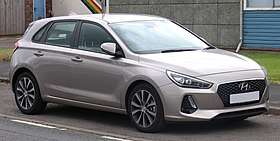
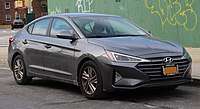

_Premium_sedan_(2017-07-15).jpg)
_front_in_bright_red%2C_NYIAS_2019.jpg)



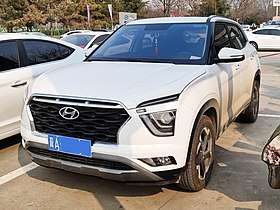

_Active_2WD_wagon_(2018-10-12)_01.jpg)
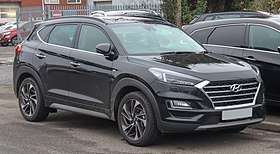
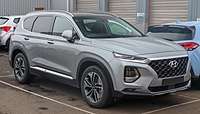


.jpg)